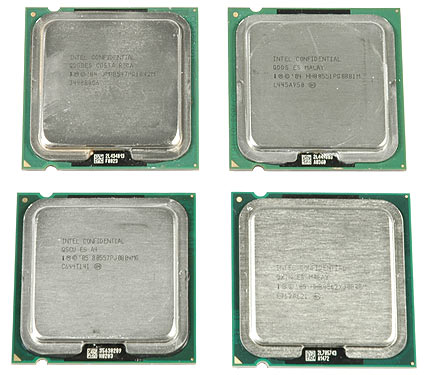Intel Power Consumption Then and Now
From Pentium 4 to Core 2: Power Consumption Analyzed
The processor typically is the most power hungry component inside an average desktop PC. CPU power consumption first became a real issue as Intel closed in on 4 GHz with its Pentium 4, where 100+ watts was required and optimized cooling became a necessity. However, power requirements and performance did not match up with this chip. The advent of the first Pentium D 800 dual core processor made things even worse, until Core 2 Duo came to the rescue 18 months ago. We have since seen a 400% performance per watt increase, from the Pentium 4 600 series to the recent Core 2 processors. We'll look at some details of that evolution in this article.
When we looked at the typical power consumption of two AMD and Intel systems, we tracked the total power required to perform real-life tasks over time, simulated by BAPCo's SYSmark 2007. This benchmark is based on real-life applications, which process real-life workflows in a multitasking environment. While most publications release test results of minimum and maximum power requirements of components and systems, these results only tell a small part of the story. Power consumption has to be related to performance at all times, because a faster system may return to a more energy-efficient state earlier than a slow machine, and thus consume less power over time, even though the faster solution might have a higher maximum power requirement.
Our first article dealt with an AMD Athlon 64 X2 5000+ (65 nm) and Intel's Core 2 Duo E6400 Compare Prices on Core 2 Duo E6400 . Both are fast and efficient dual core processors, but Intel's Core 2 Duo won the efficiency battle due to its performance advantage, allowing it to resume an idle state quicker than the AMD processor. But how does the Core 2 Duo compare to the Core 2 Quad? And how much better is it when compared to the Pentium 4 and the Pentium D? Let's have a look!
Get Tom's Hardware's best news and in-depth reviews, straight to your inbox.
Current page: From Pentium 4 to Core 2: Power Consumption Analyzed
Next Page Processors at 3.0 GHz
Patrick Schmid was the editor-in-chief for Tom's Hardware from 2005 to 2006. He wrote numerous articles on a wide range of hardware topics, including storage, CPUs, and system builds.
-
hkazemi The 'SYSmark Performance per Watt' can be misleading when comparing the dual and quad core processors, particularly when looking at other types of loads that make better use of the additional cores. In particular, look at x264 encoding, where a quad-core processor offers nearly double performance. See the graysky's articles on TechARP for actual charts and tables:Reply
http://www.techarp.com/showarticle.aspx?artno=442
http://www.techarp.com/showarticle.aspx?artno=520
For a load that will use all processors, I believe that testing will show better performance per watt for a quad core compared to a dual (or even single) core because there is little or no additional overhead from the motherboard or powersupply or hard drives when adding an additional core.
It may be easier to understand this by comparing running 2 separate PCs with dual core CPUs in them vs. running a single PC with a quad core CPU. The quad core system won't need another motherboard, power supply, fans, drives, etc. so all those items are areas of power savings.
From the published tests above, the 2 extra cores consume 195-132=63 watts at max load and 94-77=17 watts at idle. That is in contrast to adding a 2nd system identical to the E6850 testbox which used 132 watts at max and 77 at idle.
A simplistic scaling using a spreadsheet, and assuming that performance doubles going from dual to quad cores (reasonable for x264 encodes), shows that:
state cores watts perf/watt perf perf/core perf ratio
Idle 2 77 1.46 112.42 56.21 1
Idle 4 94 2.391914894 224.84 56.21 1.638
Avg 2 90 1.46 131.4 65.7 1
Avg 4 112 2.346428571 262.8 65.7 1.607
Max 2 132 1.46 192.72 96.36 1
Max 4 195 1.976615385 385.44 96.36 1.354
In other words, using the system power numbers given, the quad core can be 35% to 64% more efficient than using a dual core, if given an appropriate load. A look at the Sysmark benchmark scores will show you that it did not scale up very much going from dual to quad. -
archp2008 You said, "You cannot upgrade an existing Pentium D or Pentium 4 system with a Core 2 Duo processor, so you will have to purchase a new motherboard supporting the new processors, as well as DDR2 or DDR3 memory." My wife's P4d is on a Fox 45cmx mobo. The E6850 is listed on the support list. I was thinking of upgrading to the E6850 dual core.Reply
